Leading big shifts across an organization requires planning, pivots, and the finesse of a leader. Honing leadership skills and building your toolbox are crucial to ensuring innovation in your communities.
As districts gear up to write their next strategic plan, many have mixed feelings about the process. At best, the process provides an opportunity for district leaders to coalesce around a shared vision and produces a dynamic plan reflective of various stakeholders’ needs. At worst, the process consumes valuable hours and produces a document that does little to change individual behavior and sits on a shelf collecting dust over the next five years.
We think there’s a better way. In his book, The NEW School Rules: 6 Vital Practices for Thriving and Responsive Schools, our CEO Anthony Kim writes:
U.S. General Dwight Eisenhower said, “In preparing for battle, I have always found that plans are useless, but planning is indispensable.” If “better student outcomes” is our shared mantra as educators, we need to stick vigilantly to that purpose as our guiding principle and direction, not the plans we make to get us there. We need to approach planning as a way of thinking, not a set “product” or “plan” that has value in and of itself.
At Education Elements, we challenge our district partners to focus more on the planning process rather than a static plan as the end goal. Why? By focusing on the planning processes, districts are better able to:
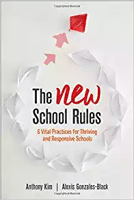
As schools and districts grapple with the long-term impacts of unforeseen circumstances and crises, it's important to consider the role of responsive planning in order to successfully pivot when needed. Educators planning a return to school in a new state of normal can rely on tried and tested practices to support them.
Learn how to use responsive practices to plan your district's return, with a four-step process for examining multiple return scenarios amid uncertainty and unknowns.

Each time you create a strategic plan, with all the time, effort, and expenses that it entails, you know that it will live with your district for years. We consider the following seven steps – including asking questions before getting started, planning to engage stakeholders throughout, forming planning teams, and setting up a monitoring process – are crucial to developing a responsive plan.
Generally, districts create strategic plans for periods of 3-5 years, so it is important to ask the right questions before starting the process.
For more details, check out The 4 Biggest Questions You Need to Ask Before You Start District Strategic Planning, by Associate partner Andrea Goetchius.
As you begin a new initiative or kick off your strategic planning process, it is essential to engage your community intentionally to clarify their priorities, pain points, and pressing questions. A deep understanding of your stakeholders will ensure the following outcomes through your planning process, and in the final product:
First encounters with your stakeholders are critical – they set the precedent of how you will engage them throughout this process.
At Education Elements, through our work with teachers, campus leaders, and district administrators, we have developed and refined a process for stakeholder engagement that we think can be applied to any project. Our Stakeholder Engagement Guide identifies the key steps and a variety of methods that schools and districts can use to get input and facilitate buy-in from students, teachers, staff, parents, and community members.


Reviewing options for the different ways you can engage different groups will ensure that the time you spend developing your tools and conducting your research will have the most impact. Tactics may include:
Often, when kicking off a strategic planning endeavor, everyone wants to be involved. We know how critical it is to accurately represent the needs and values of your community and ensure you have a lean decision-making body, so here is some guidance on involving all who are invested in the outcome of your plan. Selecting Your Team: We believe that there are ways to include representative voices and ensure a nimble decision-making process. Consider taking the following simple steps to select strategic planning teams: • Identify everyone you want to involve • Plot the individuals on your list in the engagement matrix • Select the level of involvement of each individual.
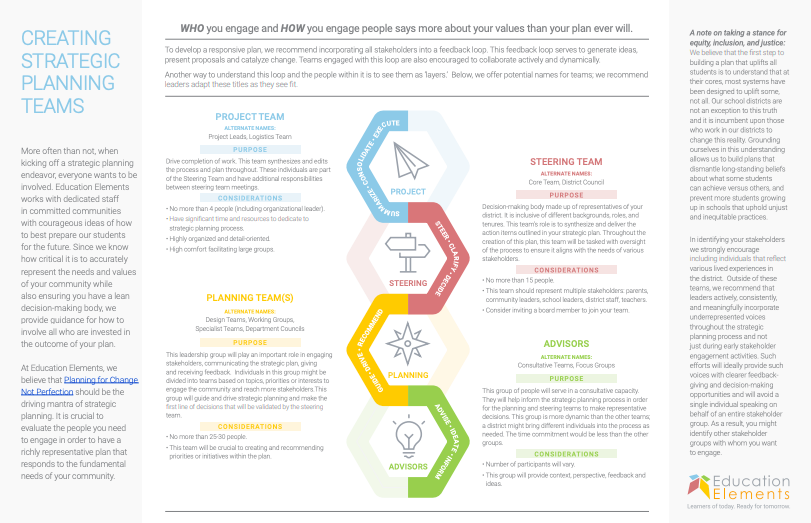 Access the Strategic Planning Teams Guide here
Access the Strategic Planning Teams Guide here
When it comes to selecting a team to build your strategic plan, identify a superhero team of your own – someone who represents multiple voices in your community and is an agile body that executes flawlessly (to save the city, of course).For more details on how to do this, read Three Steps to Selecting Your Superhero StrategicPlanning Team, and use the Creating Strategic Planning Teams guide to help you determine what your teams should be, and who should be on them.
This step is often done in tandem with engaging your stakeholders, as it is the phase where you and your team honor your community’s perspective and your own insider knowledge as you continue to build your district’s strategic plan. While STEP 2 addresses the set-up or the how of stakeholder engagement, this step addresses the “OK...now what?”
To put it another way: a common question we receive while working with districts is, “We have collected all of this data from different stakeholder groups, but how do we sort through it all?”
Our hope is that the following steps will give you and your team some guidance in answering this question.
Here are our suggestions on how to move this forward, and leverage the data you have collected throughout the stakeholder engagement process.
As you’re beginning your design process, you’ll want to ensure you’re involving and focusing on those who have identities often marginalized by design.
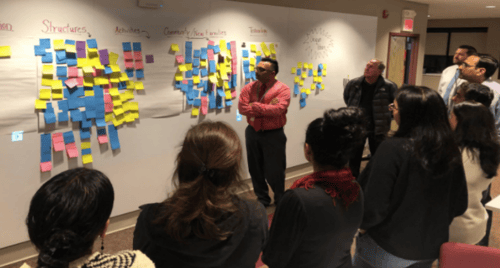
After distributing a survey, hosting community forums, and conducting 1-1 interviews, the Steering Committee hosted community planning nights to analyze data from these events and identify the district’s greatest needs. During these nights, the Committee used protocols like the ‘Wall of Ideas’ to challenge the district status quo and brainstorm solutions. Outcome: Steering Committee confirmed focus areas and could begin prototyping solutions
Whether you are developing a new strategic plan or going through an existing one, the following steps are what we recommend to begin designing the ‘solutions’ or supports around your community’s identified focus areas.
To get started using it, follow the four-step process below:
1- Make a list of all of your strategic planning focus areas.
2- Define what “impact” means for your team. Then, distribute your post-its along a continuum of Impact. Define what “ease of implementation” means for your team.
3- Then, distribute your post-its along a continuum of Ease and Impact.
4- Finally, select 2-3 initiatives to implement first from the sweet spot. Now that you have your prioritization matrix, your strategic planning team can begin implementation with the confidence that you are starting with a manageable and high-impact list.
Now that you have your prioritization matrix, your strategic planning team can begin implementation with the confidence that you are starting with a manageable and high-impact list.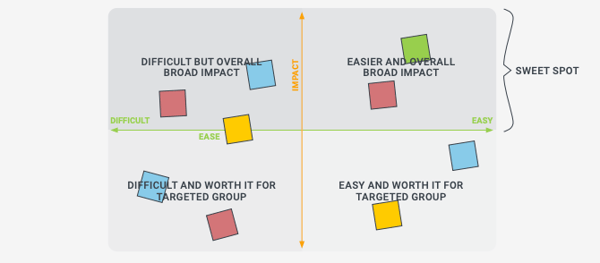
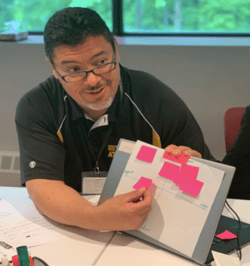 Approach: The Steering Committee reviewed the prototypes and evaluated initiatives according to their ease and impact of implementation to identify priorities. The Committee also planned to communicate the strategic plan to their stakeholders.
Approach: The Steering Committee reviewed the prototypes and evaluated initiatives according to their ease and impact of implementation to identify priorities. The Committee also planned to communicate the strategic plan to their stakeholders.
Outcome: A timeline for initiative implementation was developed to account for the next three years of execution.
Want more information? Check out the South Brunswick School District Strategic Plan Deployment Document.
Over the past several years, we have engaged with hundreds of districts and witnessed a broad range of schools working to shift instructional practice to be more student-centered, and leadership practices to be more responsive. What is the surprising “secret sauce” of their success? Communications.
School districts that develop thoughtful communications plans do more than just push important information out to their stakeholders. These districts build a culture of engagement, transparency, and trust that is critical for innovation and change, and sustainable and scalable across teams and buildings. Change can be difficult, and even scary, and districts need a strong culture of communication to succeed.
That’s why we released a communications guide that provides a streamlined planning process, shares real-world examples, and offers up-to-date resources and artifacts. Check out the communications guide here. In addition to this guide, we recommend you explore all the communications channels and platforms that you own, and strengthen your presence. The series below can give you ideas about how to make your strategic plan ubiquitous to your audience and community.
Our approach to strategic planning rests on the following three principles:
Just like sports teams hold practices before games, a responsive planning process offers a valuable opportunity for district teams to practice working together. The most effective teams have developed a deep sense of trust. Districts should not wait until after the strategic plan is published to develop effective project management structures, monitoring systems, and processes for team learning. We believe that during the strategic planning process, district teams should start building habits and ways of working together that will carry forward into the implementation of the plan. Try out our Planning Workout 1A: Build Your Skills to Plan Using Known and Anticipated Data and our Planning Workout 1B: Build Your Skills To Think In “Planning,” Not “Plans”.
Too often, districts treat stakeholder engagement processes as a one-way street, focused solely on gathering community input. We believe the strategic planning process offers an excellent opportunity to educate stakeholders about why this planning process is different and what it means for each person. Districts must create urgency and identify the impact on the community. The stakeholder engagement process should build knowledge and excitement; teach the community about why we are doing strategic planning differently; and enable the district to collect data and feedback from the community about successes and challenges from the previous strategic planning round.
We’ve seen too many strategic plans that include specific actions that are supposed to take place three or four years in the future. It’s impossible to know if those will be the right steps to take given ever-changing conditions. Instead, we believe that a strategic plan should identify major themes and goals for each year, but focus more effort on developing a rigorous methodology that will give district leaders more accurate information in order to make better planning canvases.
EXAMPLE #1: South Brunswick School District
EXAMPLE #2: Clyde Savannah Strategic Plan
EXAMPLE #3: Enlarged City School District of Middletown
There is no perfect template or framework for your strategic plan. Each plan should be unique to its district, reflecting its reality, context, resources, vision, and unique community beliefs. A strategic plan should also be visually comprehensive, and speak to the district’s audience and community.
A simplified way to look at how we approach strategic planning is to focus on these 3 buckets/questions:
WHY, HOW, and WHAT
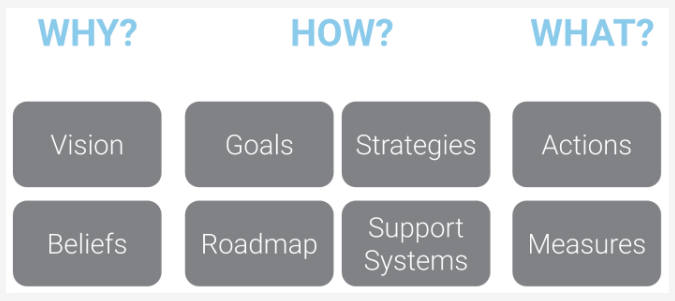
We also recommend using this visual planning tool by Kawai Lai Consulting.
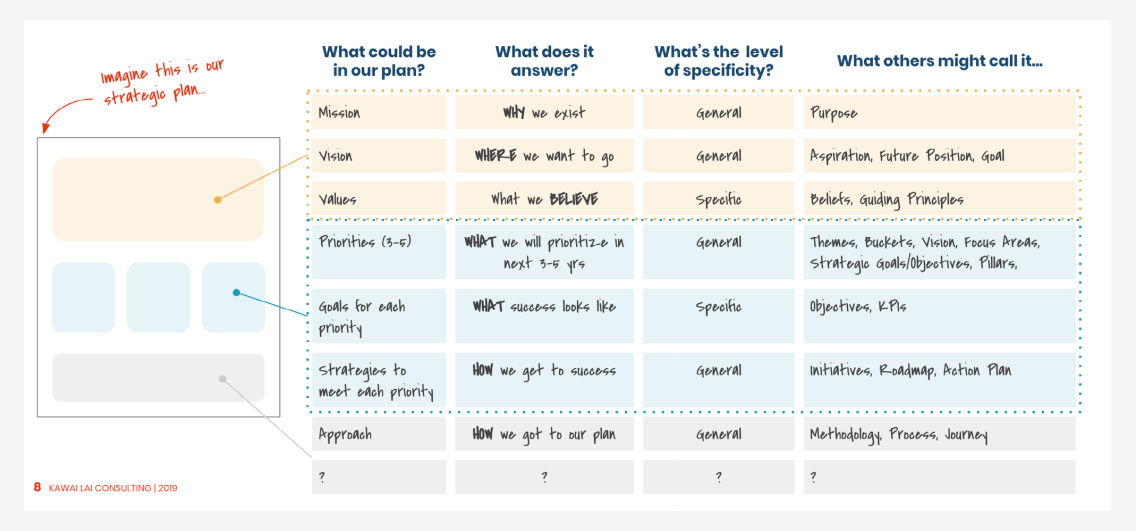
Once you have a clear plan, and through the strategic planning team of heroes that you have developed, you can give more agency to the leaders in your organization. We recommend developing innovative leadership competencies, and this guide will help you do so.
What does it mean to be an innovative, responsive leader in your community? The most successful school and district leaders are those who have the tools and mindset to develop communities in which teacher-led innovation is fostered, supported, empowered and celebrated. The good news is that you have the power to create this kind of leadership in your district and schools.

Check out our approach to The Entry Plan for an Incoming Superintendent